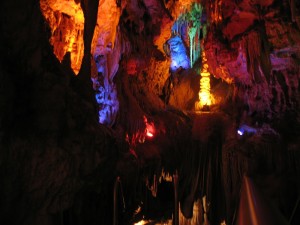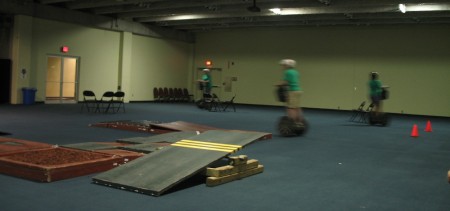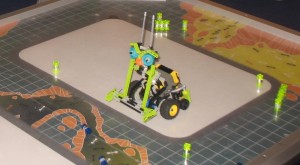A wonderful demonstration of sound waves, frequency especially, expressed in propane fire. It’s called a Ruben’s Tube.
Category: Natural World
Sinkholes
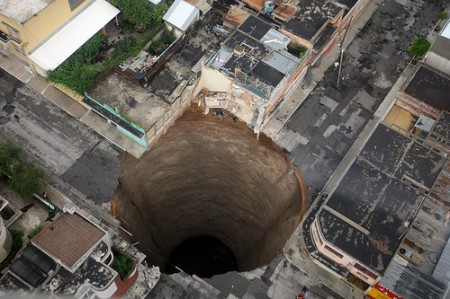
The caves at Meramec were created in dissolved carbonate rocks; that’s how most caves with interesting cave formation form. The recent storms in Guatemala, along with leaky sewage pipes, have helped speed the dissolution process producing some devastating sinkholes.
[googleMap name=”Guatemala City” description=”Guatemala City” width=”450″ height=”400″ mapzoom=”4″ mousewheel=”false”]Guatemala City[/googleMap]
Spelunking at Meramec

On the last day of our trip we drove an hour west of St. Louis to Meramec Caverns. If you’re ever on I44 heading out of St. Louis you can’t miss it. From 30 km away you start seeing billboards, sometimes in pairs, almost every 100 meters.
Largely this is because it is a privately owned cave. Privately owned also means that they can do things to “enhance” the cave that you would not see at a National Park like Mammoth Cave. The light shows in certain caves were particularly interesting. Our tour guide was pretty good, entertaining and scientifically accurate for a general audience.
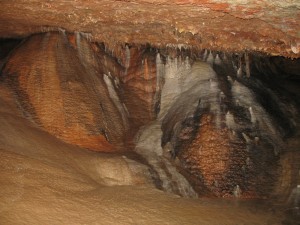
The presence of different colors in the rock formations (red, white and black) due to different metals in the carbonate precipitates could tie in very well with our discussion earlier this year of ionic bonding.
There are also historical tie-ins. The cave was the site of a skirmish during the civil war, because the bat guano was being used to produce gunpowder. Jesse James participated in that engagement and later used the cave as a hideout.

Finally, they have a reconstructed hut, which although it has nothing to do with the cave, has a bootlegger’s still does link with our discussion of steam distillation.
Scientists tracking oil plumes
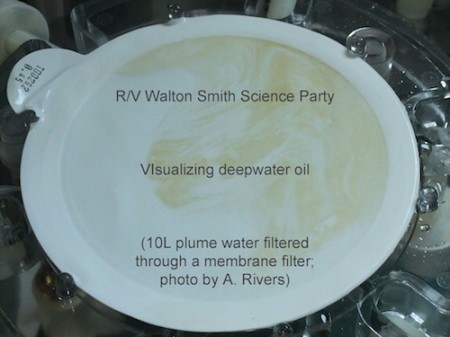
As oil continues to leak from the damaged well in the Gulf of Mexico and the surface slick is affecting more and more of the coastline, scientists now using research vessels to track the underwater plumes spreading at depth throughout the gulf.

Satellite imagery from NASA only shows what’s at the surface. To find the underwater plumes, researchers on boats lower instruments on cables that measure the chemistry of the water. Certain chemicals, like colored dissolved organic matter (CDOM) are produced when there is a lot of oil in the water.
Dr. Samantha Joye, from the University of Georgia, is the lead scientist on one such vessel. She started the Gulf Oil Blog where she describes her ongoing work in the gulf and answers readers questions. It is an excellent resource. A great demonstration of science in action, working on a practical problem but using techniques and methods developed over time for answering more abstract questions.
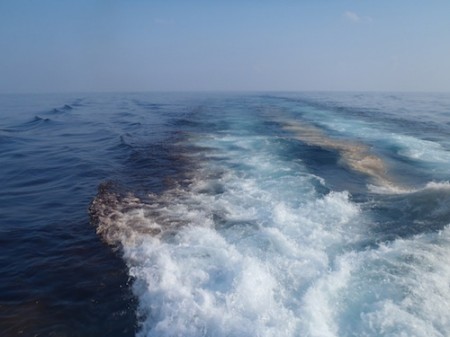
Gardening in small spaces – self-watering containers
The above video, on how to build a self-watering container (this type is also known as a Global Buckets), seems extremely useful for the urban gardener, especially in Memphis where even gardening in the ground is difficult because of the poor, loessic soil. I’ve found container gardening (in cat litter buckets) to be much more effective, even though evaporation is a major issue with our hot summers. So I very much like the idea of self-watering containers.
These containers may also be an excellent complement to our greenhouse, because we can avoid having to water every day. If we got the right containers, or decorated them nicely enough, we might be able to sell these with our vegetables at the end-of-year plant sale.
The related videos on YouTube have a variety of other self-watering container variants. This version, with water jugs and a single large tub, also seems like it might be effective. There are also nice instructional video on how siphons work, as an easier way of watering a series of buckets. The Global Buckets project is a fascinating effort to help reduce malnutrition with simple materials.
Segway lessons
From playing with robots we tried an actual application of robotics. We had the Segways 101 course at the St. Louis Science Center.
The lesson itself was fun, with an entertaining video of people falling off Segways. They also had a little obstacle course to let you try doing all of the things the video told you not to do (but most of it was for the more advanced class).
Afterward, we discussed the fact that this too was robotics and a pretty advanced application at that. We did not talk much about how the Segways were supposed to revolutionize urban transportation but students did recognize the fact that aesthetics were a major impediment to their broader adoption.
The price was a bit steep however, and I’m a little conflicted about if it was worth it.
Lego Mindstorms
I’ve been curious about the Lego Mindstorms robotic systems for a while now, and I had my first chance to try them at the St. Louis Science Center.
The kits come with a micro-controller, a few motors and some sensors. While there are quite a number of ways of assembling these to make robots, the ones at the science center were pre-built except that you could just plug in a bulldozer or sweeper attachment (and a head which was purely decorative). This limited the degrees of freedom to three, which made it easier to program something useful in the hour we had with the robots.
The programming is very basic. There are two sets of instructions, one to control the movement of the robot in general, and one to control its response when the sensor detected a change in the environment. The objective of the science center’s game was to clear off a set of objects from a white rectangle within five minutes.
You could tell the robot to move forward, back or rotate while it’s on the board and to activate its sweeper or shovel. So a full program could have just five elements; general: lower shovel –> move forward –> rotate; sensor: move backward –> rotate. With these strict limitations, the programming interface is also very simple; you plug in blocks with each instruction in the series for either the general movement or the sensor reaction. With all this simplification, I’m not sure just how much the students learned about programming from our short session.
The full kit from Lego offers more freedom to design robots and thus more flexibility with the programming interface so with a little thought it could be easily integrated into the curriculum. At about $300 each the system is a bit pricy, we’d probably need to get one kit for each small group of 3-4 kids. They would probably be worth it however if we used them more than just once.
I’ve been playing with the Basic Stamp micro-controller for a while, and while it offers almost infinite flexibility, making it more useful for practical applications, it does not provide the immediate gratification of the robots, and the ease of assembly to make it the better tool for introducing robotics to middle schoolers. I still, however, tend to favor practical applications, so perhaps I can persuade a student to do an advanced project to build an automatic window for the greenhouse.
The session at the Science Center was worthwhile. All of the students seemed to enjoy it. It provided a nice integration of the mechanics and electronics we’ve been learning about all year, and a glimpse of where technology is taking us in the future.
Anheuser-Busch and the industrial revolution

Why take a group of middle schoolers on a tour of the Anheuser-Busch factory? After all, no one will be trying any samples and the main point of the museum and the tour itself is to make people feel good about the company and buy more of its products. Which would be beer.
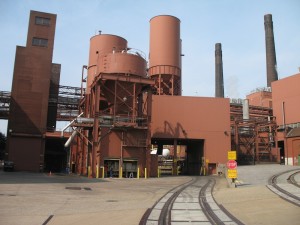
The answer is that the history of the company ties directly into the history of the industrial revolution in the U.S.. Its large scale industrial process was made possible by the serendipitous German immigration into St. Louis in the late 1800’s. Just then the expansion of grain farming in the mid-west and the railroads could supply the raw materials for beer on a massive scale. New assembly lines and automation could efficiently process these inputs, resulting in large scale production. Successes bred new inventions, with the company retaining the services of Rudolph Diesel to introduce his engine to the U.S..

The survival of the company during prohibition (1920-1933) was another point of interest. Anheuser-Busch survived by diversifying from its core business, making non-alcoholic drinks and selling baker’s yeast among other things. At the end of prohibition, Anheuser-Busch was the only large brewer left in the city St. Louis.
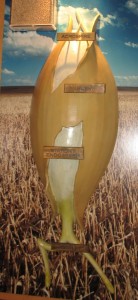
We also saw a bit of chemistry during the tour. The breakdown of complex starches into sugars as part of the fermentation process is a basic example of organic chemistry in action (polymers –> monomers). Light beer, for example, is kept in the tanks longer so that more of the starches are broken down into simple sugars. There were even a couple of big models of barley grains and hops buds showing their parts, that tie in to our life-science lessons next year.
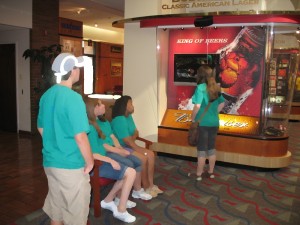
Even the surfeit of advertising could be used to advantage; the first thing inside the door of the museum is a television playing Anheuser-Busch’s most successful commercials. We’ve been discussing propaganda all year, so the students were somewhat inoculated to the barrage of feel-good messages, and we specifically discussed this in our post-tour group meeting.
Our tour guides were great. Informative, friendly and willing to answer questions, I particularly appreciated that they joined us in our group discussion after the tour and answered the questions that came up as best they could.
This tour exceeded my expectations.
